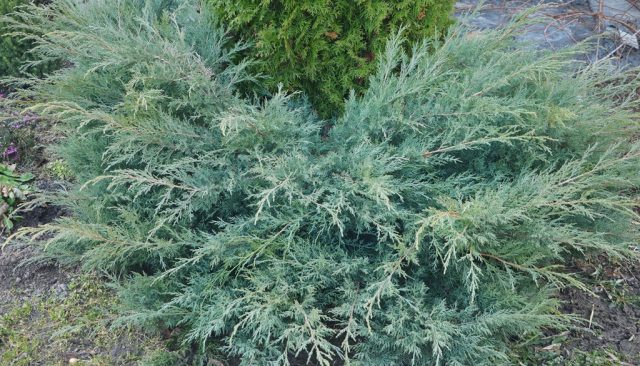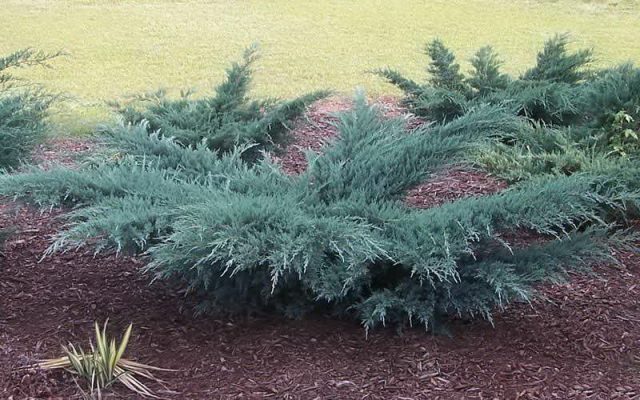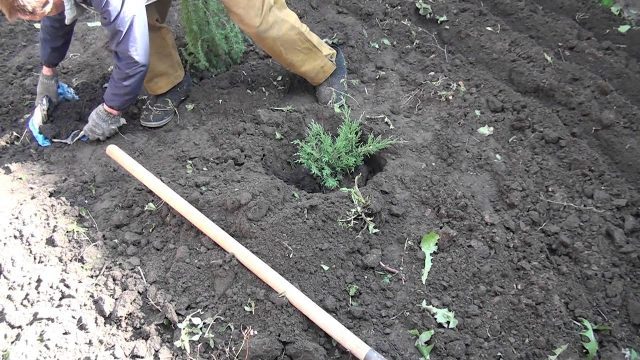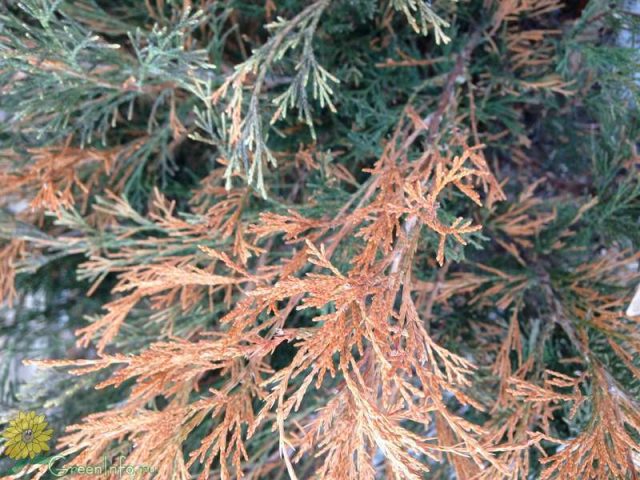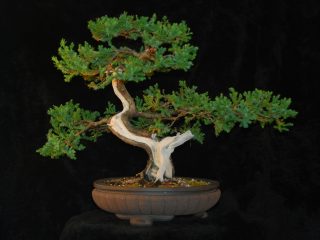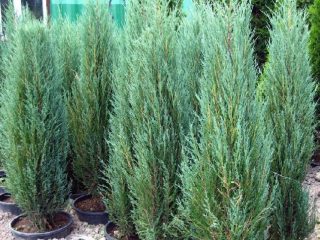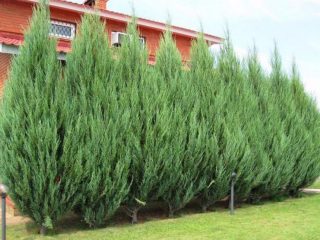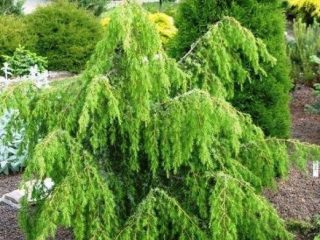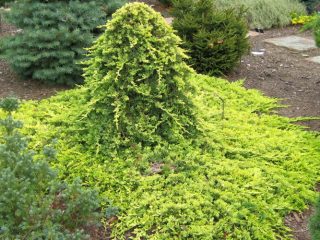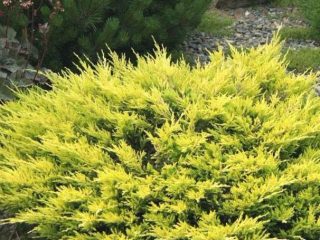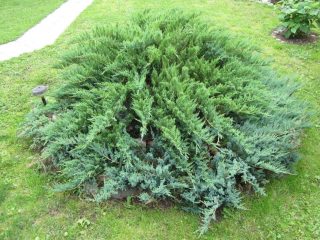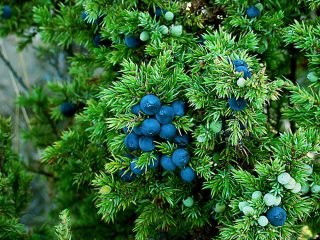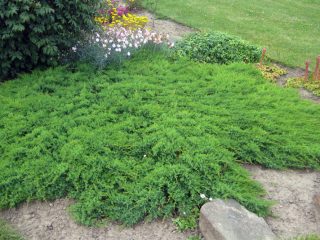Content
A summer cottage cannot be imagined without coniferous plants. But not every conifer can survive the frosty Russian winters. The most cold-resistant is juniper, which can have horizontal miniature forms and grow into a tall tree with hard and tender needles. One of the most common varieties for the cold Russian climate is Virginian juniper Gray Oul.
Description of juniper Gray Owl
The plant is slow-growing; shoots grow 10-15 cm per season. During growth, the conifer forms a spreading crown, covered with soft smoky-blue needles. An adult shrub grows up to 3 m, forming a funnel-shaped crown up to 5 m in diameter.
The evergreen shrub can be grown in all corners of Russia, since Juniper Virginian Gray Oul has high winter hardiness and can easily tolerate summer heat and polluted air.
Virginia juniper has a large number of positive qualities:
- early fruiting;
- propagation by cuttings, seeds and offshoots;
- drought tolerance and frost resistance;
- not picky about care;
- After formative pruning, it retains its crown shape for a long time.
Many gardeners have found negative qualities in juniper virginia:
- slow growth;
- does not tolerate transplantation well.
To have an idea about the variety, you need to carefully read the description and look at the photo of Gray Ole juniper.
Juniper Gray Owl in landscape design
The variety is widely used for landscaping garden plots. It is planted to make coniferous compositions or as a separate plant. The decorative appearance of the crown can be created thanks to formative pruning.
Thanks to the detailed description, anyone can decorate a plot with Virginia Gray Ole juniper, since the shrub has zone 4 frost resistance.
The evergreen juniper virginiana Gray Oul will decorate the garden in the summer with light blue needles, in the fall with gray berries, and in the winter with lilac spreading shoots.
Planting and caring for Gray Owl juniper
Juniper virginiana Gray Oul is an unpretentious variety. Can grow on any soil, in any weather conditions, in sunny or shady areas. But if favorable conditions are created, the bush will show itself in all its glory and will become an indispensable decoration of the summer cottage. Before purchasing a seedling of juniper virginiana Gray Oul, you need to familiarize yourself with the characteristics of the variety.
Preparing seedlings and planting area
Juniper virginiana Gray Oul seedlings must be purchased from nurseries or from trusted suppliers. The shrub is sold with an open root system and in containers. When purchasing a variety, you need to know certain rules:
- The younger the plant, the faster it adapts to a new location.
- Saplings with open roots are planted in spring and autumn, with closed roots - from spring to autumn.
- The root system should be well developed, without signs of rot or mechanical damage.
- The needles should have a rich color, without signs of disease.
Before planting, the plant must be selected and prepared. Since the variety forms powerful and rapidly growing roots, a spacious, large area must be allocated.
A plant in one place can grow up to 50 years and does not tolerate transplantation, so choose a sunny area with well-drained soil. If you plant the plant in the shade, then Juniper Virginian Gray Oul will lose its decorative effect. The best soil for planting is sandy loam or loam. If the site has heavy clay soil, lighten it with peat and river sand before planting.
Virginia juniper tolerates drought well, but in moist soil the root system quickly rots and the plant dies. Therefore, it is necessary to avoid areas with shallow groundwater.
Landing rules
Once the seedling has been purchased and a location has been chosen, you can begin planting. To do this, dig a planting hole 2 times wider and deeper than the diameter of the earthen ball. The bottom is covered with a 15 cm layer of drainage, complex mineral fertilizers are added, and sprinkled with nutritious soil.
Juniperus virginiana is installed in the hole so that the root collar is located at ground level.Next, the bush is carefully sprinkled with earth, compacting each layer to prevent the formation of an air cushion. The top layer is compacted and shed generously.
Many novice gardeners make mistakes when planting juniper virginiana Gray Oul:
- Violation of the earthen coma – if the roots are exposed, the plant will not take root well, development and growth will stop.
- Small hole for planting – the root system of juniper virginiana is powerful and for rapid growth, a palm must fit between the walls of the hole and the earthen lump.
- Deepening the root collar – the plant stops in growth and development, as a result of which it dies.
Juniper virginiana Gray Oul is an unpretentious variety. But in order to get a beautiful plant, you should not neglect the basic rules of care: watering, fertilizing, formative and sanitary pruning, loosening and weeding.
Watering and fertilizing
Since juniper virginiana Gray Oul is a drought-resistant variety, watering is carried out only in dry summers, once every 30 days. To obtain a sufficient amount of moisture, pour up to 2 buckets of water under each adult plant. Also, the plant will not refuse weekly spraying in the evening.
For better growth and development, juniper virginia needs to be fed twice a season. In the spring, nitroammophosphate is applied, and in the fall, phosphorus-potassium fertilizers are applied. To avoid burning the root system, fertilizers are applied in combination with watering.
Mulching and loosening
To ensure access of oxygen to the roots and prevent the appearance of an earthen crust, after rains and watering the soil must be loosened and mulched.Mulch will retain moisture, become an obstacle to the growth of weeds, prevent overheating and freezing of the roots, and will serve as an additional organic fertilizer. Peat, sawdust or pine needles are suitable as mulch.
Trimming and shaping
Virginia Gray Owl can form a good crown without pruning, but to give the shrub a decorative appearance, it needs to be pruned regularly. Since the plant is slow growing, pruning must be done extremely responsibly. Otherwise, in case of an error, the bush will take a long time to restore its strength. For juniper virginiana Gray Oul, it is enough to carry out sanitary pruning once a year, removing dry and damaged branches.
Preparing for winter
Virgin Gray Owl is a frost-resistant variety, so it does not need shelter for the winter. Only young seedlings need to be protected from frost. To do this, the bush must be prepared for cold weather:
- A month before the onset of frost, the bush is watered generously and fed with phosphorus-potassium fertilizers.
- The ground around the plant is covered with spruce branches, and the crown is hidden under covering material.
Reproduction of juniper virginiana GreyOwl (Gray Owl)
Gray Owl can be propagated in 3 ways:
- cuttings;
- seeds;
- bends.
Propagation by seeds is a labor-intensive process, and not everyone can do it. Therefore, to propagate the variety, it is better to use other methods.
Cuttings are an easy and effective method of propagation.
- In August, lignified, young cuttings are cut.
- Harvesting is carried out in cloudy weather.
- The cut is made with a sharp, sterile instrument.
- The cuttings are treated with “Kornevin” or “Epin”.
- Prepared shoots are buried in nutrient soil, shed and put away in a warm place. The optimal temperature for rapid formation of the root system is 16-20 °C.
- After new foliage appears, the temperature is increased to 26 °C.
- Rooting cuttings are very demanding when it comes to watering, so spraying is carried out once a week.
- A new young plant is planted in a permanent place a year after the roots appear.
Reproduction by cuttings is the simplest method, which does not require additional effort and time.
- The soil around the bush is carefully loosened and fed.
- The lower shoot is cleared of needles, laid on the ground and secured with a metal bracket.
- The shoot is sprinkled with earth, watered and mulched.
- In the spring of next year, the rooted seedling is separated from the mother bush and transplanted to a prepared place.
Diseases and pests
The variety is immune to many diseases, but if agrotechnical rules are not followed, it can become infected with Alternaria necrosis. These fungal diseases can be recognized by a black coating on the needles. As a result, it falls off and the shoots dry out. You can get rid of diseases by treating them with a copper-containing preparation.
To avoid problems, it is necessary to regularly carry out preventive measures:
- loosening and weeding;
- sanitary pruning;
- burning pruned branches;
- At the first signs of disease, treat the plant with Fitosporin.
Conclusion
Versatility and unpretentiousness are ideal characteristics that allow you to grow Virginia Gray Oul juniper for landscape design.Thanks to its gray-blue needles, the plant looks great with other conifers, in rose gardens, in flower beds with bright perennials and next to ornamental shrubs.
